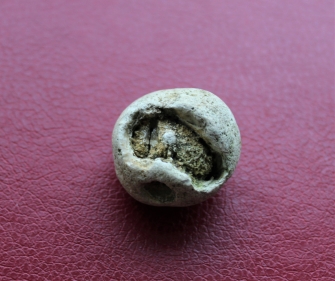


TYRANNOSAURUS STUFF:
FOSSILS
ON THE BEACH
OK, so not many of us are going to dig up the skeleton of a new species of Tyrannosaurus Rex, it is not unusual to find a few fossils from marine creatures on the beach.
This is the BeachStuff guide to some of the more common fossils beachcombers are likely to find.
If you have found fossils we haven't featured, please send us your photos! We'd love to feature them.

Fossils = happiness.
Ammonites
These are arguablly the most commonly found fossil by the casual beach-walker. While they look llke garden snails with their spiral shells, they are actually related to squid and octopus and their squid-like legs could be seen sticking out of the shell where a snail's head would be.

The imprint of the ammonite on the left was found on the beach, the ammonite on the right, highly polished, was found in a shop.

Ammonites can be found in huge sizes.
Ammonites apppear in the fossil record around 240 million years ago and they disappeared around the same time as the dinosaurs some 65 million years ago.

The topside and underside (below) of a grypaea fossilised shell

Gryphaea, in practice, didn't have anything to do with anything Devilish. They are actually a type of oyster so would have been made up of two shells which hinged together.
They were around from 250 million years ago right up to 43 million years ago, or thereabouts.

A few fossilised shells of other bi-valves.
Should we take home fossils
we find on the beach?
Fossils, especially large or rare ones, can fetch huge sums of money. For this reason, people can be very tempted to take them home with them.
However, the finders keepers rule may not apply and the landowner may actually have a more legitimate claim to ownership.
It is always wise to ask permission from the landowner if you want to remove anything from a beach.
Belemnites
These bullet-shaped finds are actually the fossilised remains of a squid-like marine creature from the Cretaceous Period so could be between 237 and 66 millions years old.
Belemnite fossils are often pointless, like the blunt example in the background.

Sea Urchins
There's a whole page on sea urchins here and the delicate tests (skeletons) we can find on the beach. The advantage of finding a fossilised one, like the one below, is that you are far less likely to break it in your pocket on the way home.
Sea urchins first appeared in the fossil record around 450 million years ago are officially very very old. Still have to pay for their TV licences though.

A sea urchin fossil about the diameter of a 50p piece. Much larger examples can be found (by people luckier than I am!).
Below is a sea urchin perfectly preserved in a flint pebble.

Crinoids
Crinoids are marine creatures related to sea urchins and starfish. They are essentially a stalk with a crown of rays/legs. What a starfish would look like if it were an umbrella?
They date from 480 millions years ago but haven't disappeared yet - crinoids still live in our warmer seas.


This rock has crinoid stems embeddd within it. The rectangles are stalks 'cut' longways, with the smaller pieces being cross-sections across the wdith of the stalk.

A piece of crinoid stem

A cross-section of a crinoid stem exposed in the bedrock

This fossil of crinoids was photographed by Sanjay Acharya This file is licensed under the Creative Commons Attribution-Share Alike 3.0 Unported license.
Shark teeth
It is increibly unusual to find fossilised parts of a shark's body but not that uncommon to find a fossilised tooth. This is perhaps, in part, a shark only had one body but could lose up to 35,000 teeth during its life!
Sharks are old, having been around for some 450 million years but most of the teeth we find are 'only' about 60 million years old.

The flattened tooth on the right is probably from something like a nurse shark that uses them to munch on cras. The triangular tooth on the left may have come from a shark and used to cutting through the flesh of larger, meatier prey.







